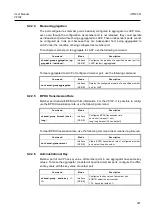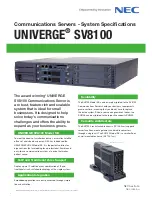
UMN:CLI
User Manual
V8102
312
9.1.2
Protocol-based VLAN
User can use a VLAN mapping that associates a set of processes within stations to a
VLAN rather than the stations themselves. Consider a network comprising devices sup-
porting multiple protocol suites. Each device may have an IP protocol stack, an AppleTalk
protocol stack, an IPX protocol stack and so on.
If we configure VLAN-aware switches such that they can associate a frame with a VLAN
based on a combination of the station’s MAC source address and the protocol stack in
use, we can create separate VLANs for each set of protocol-specific applications.
To configure a protocol-based VLAN, follow these steps.
1. Configure VLAN groups for the protocols you want to use.
2. Create a protocol group for each of the protocols you want to assign to a VLAN.
3. Then map the protocol for each interface to the appropriate VLAN.
Command
Mode
Description
vlan
pvid
ethertype
ETHERTYPE
VLANS
Interface
[XE/GE/GPON]
Adds a port with a protocol-based VLAN.
ETHERTYPE: Ethernet type (e.g. 0x800)
VLANS: VLAN ID (2-4094)
no
vlan
pvid
ethertype
[
ETHERTYPE
]
Removes a port from a protocol-based VLAN.
Because Protocol Based VLAN and normal VLAN run at the same time, Protocol Based
VLAN operates only matched situation comparing below two cases.
1. When Untagged Frame comes in and matches with Protocol VLAN Table, tags PVID
which configured on Protocol VLAN. But in no matched situation, tags PVID which
configured on and operates VLAN.
2. When Tagged Frame comes in and VID is 0, it switches by Protocol VLAN Table. But
if VID is not 0, it switches by normal VLAN Table.
9.1.3
Reserved VLAN
Before creating/enabling a port interface or subinterface, you can specify a range of re-
served VLANs for internal purpose. To add/delete the internal reserved VLAN ID for the
port interface, use the following command.
Command
Mode
Description
vlan reserved add VLANS
Global
Assigns the reserved VLAN IDs which are internally
usable for the port interface. If the VLAN ID is already
created and assigned by user, you can not assign
same VLAN ID for the port interface or subinterface.
VLANS: VLAN IDs (2-4094)
vlan reserved delete VLANS
Deletes the assigned VLAN ID.
no vlan reserved
Clears all of the reserved VLAN IDs for the port/sub-
interfaces.














































